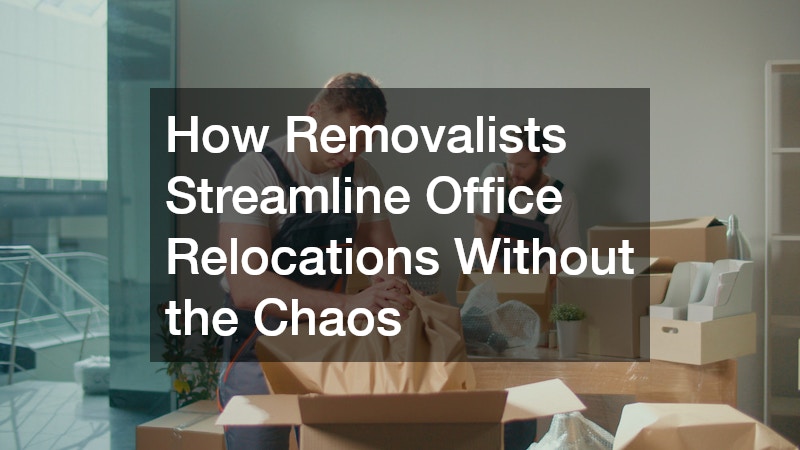Relocating an office can be an overwhelming task, marked by strict deadlines, extensive coordination and the ever-present risk of lost productivity. Whether it’s a small business shifting to a shared workspace or a corporate headquarters moving to a larger commercial hub, the complexity of an office move is often underestimated. Fortunately, professional removalists offer an efficient and structured solution to what could otherwise be a chaotic undertaking.
The Challenges of Office Relocation
Office relocations differ significantly from residential moves. In addition to desks, chairs and filing cabinets, businesses must handle sensitive documents, IT equipment, specialised machinery and ensure that all stakeholders—employees, clients and service providers—remain informed and uninterrupted.
Unlike households, offices operate under strict time constraints, where every lost hour translates into financial losses or disrupted client services.
Without a clear relocation plan and experienced support, businesses risk logistical failures. Misplaced items, technical issues, or downtime can lead to reputational damage. This is where professional movers make a vital difference.
Creating a Strategic Moving Plan
One of the most important contributions that removal specialists bring to the table is detailed planning. Removal specialists typically conduct an on-site assessment of the business premises weeks before the move, enabling them to develop a customised relocation strategy. This plan includes timelines, inventory lists, access requirements, transport logistics and contingencies for potential issues.
By coordinating with building managers, IT departments and office administrators, movers ensure that nothing is left to chance. They also assist with communicating move logistics to staff, which helps minimise internal confusion and maintains productivity in the lead-up to moving day.
Minimising Downtime & Disruption
Time is money and in business, downtime is a luxury few can afford. Movers understand this and focus on strategies that keep operations running. Many offer after-hours or weekend services, ensuring the move is completed outside of standard office hours.
Additionally, experienced removal specialists can stagger the relocation process, allowing critical departments to continue operating while others are moved in phases. This incremental approach is especially useful for large businesses that need continuous access to client records, customer service tools, or active servers.
Handling Equipment With Precision
Modern offices depend heavily on technology. Computers, servers, printers and networking hardware are not only expensive but also sensitive. Improper handling during a move can lead to irreparable damage or data loss.
Professional movers are trained to disassemble, pack and transport office technology with care. Many partner with IT specialists to back up data and ensure systems are ready for reinstallation at the new site. This integration of technical support into the moving process helps businesses get back online swiftly, reducing delays and errors.
Labelling, Inventory, & Organisation
Proper organisation is key to avoiding chaos during a move. Removalists use systematic labelling and inventory methods to ensure each item reaches its intended location in the new workspace. Colour-coded labels, floor plans and itemised checklists make unpacking faster and more accurate.
These details also streamline the reassembly process. Furniture is reassembled where needed, files are placed in the right departments and team members can resume work without having to search for missing supplies. The goal is to make the transition as seamless as possible.
Waste Reduction & Sustainable Practices
Office relocations often result in excess waste, from discarded furniture and old files to packaging materials. Professional movers help manage this sustainably. Many offer secure document shredding, e-waste recycling and donation programs for unwanted office furniture.
By diverting usable items from landfills and reducing single-use packaging, businesses can meet corporate sustainability goals while cleaning out their old space. This approach not only benefits the environment but also saves time and effort in coordinating these processes independently.
Ensuring Compliance & Safety
Workplace health and safety regulations must be followed during office relocations. Movers are well-versed in these standards and ensure that all lifting, transport and setup activities are carried out safely. From carrying heavy filing cabinets to navigating tight stairwells or elevators, trained professionals reduce the risk of injury or damage.
Furthermore, many removalist companies are insured, giving businesses peace of mind should any unforeseen incidents occur during the relocation.
Final Setup & Post-Move Support

Moving into a new office doesn’t end with unpacking. Final touches, such as setting up ergonomic workstations, aligning equipment and ensuring common areas are functional, are essential. Many removalists offer post-move support to fine-tune the new environment and troubleshoot issues that arise in the first few days of occupancy.
An office relocation can easily descend into chaos without proper planning and execution. But with the help of professional movers, businesses gain access to the expertise, equipment and coordination needed to make the transition seamless and stress-free. By managing logistics, minimising downtime and ensuring safety and compliance, these professionals do more than just move items—they safeguard business continuity.



